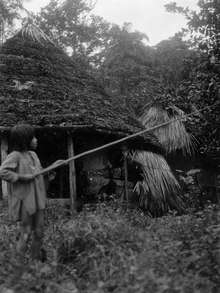Birdlime
Birdlime or bird lime is an adhesive substance used in trapping birds. It is spread on a branch or twig, upon which a bird may land and be caught. Its use is illegal in many jurisdictions.


Manufacture
Historically, the substance has been prepared in various ways, and from various materials.
In South Africa, birdlime (called voëlent in Afrikaans) is prepared from local mistletoe fruits. A handful of ripe fruits is chewed until sticky, and the mass is then rubbed between the palms of the hands to form long and extremely sticky strands which are then coiled around small thin tree branches where birds perch.[1]
A popular form in Europe was made from holly bark, boiled for 10 to 12 hours. After the green coating is separated from the other, it is stored in a moist place for two weeks. It is then pounded into a thick paste, until no wood fibres remain, and washed in running water until no small specks appear. After fermenting for four or five days, during which it is frequently skimmed, the substance is mixed over a fire with a third part of nut oil. It is then ready for use.[2]
Another popular form made in Asia is from the Ilex integra tree.[2]
Birdlime from Damascus was supposed to be made of sebestens, their kernels being frequently found in it; this version was not able to endure frost or wet.[2] That brought from Spain was said to have a bad odor.[2] That of the Italians was made of mistletoe berries, heated, mixed with oil, as before; to make it water resistant, they added turpentine.[2] It was said that the bark of the wayfaring tree (Viburnum lantana) made birdlime as good as the best.[2]
Nathaniel Atcheson in his 1811 work On the Origin and Progress of the North-West Company of Canada with a history of the fur trade... mentions birdlime (p 14) as an important import commodity for use in the Canadian west in the late 18th century.
Legal status
In July 2020, France said it is to outlaw trapping birds using sticks covered in glue after the European commission threatened legal action and fines.[3]
In the Valencian region of Spain, birdlime (locally known as parany) is commonly used to capture the song thrush, which is a delicacy throughout Spain and is used in many local recipes. In spite of the EU's attempts to curb this practice, it is still tolerated in this region.[4][5][6]
Other uses
The 4th-century BC Greek writer Aeneas Tacticus recommends (34.1–2) birdlime be used as a substance which will prevent fires from burning wood or other combustible materials, when smeared upon their surfaces.
Birdlime was used in the manufacturing of British sticky bombs during World War II.[7]
Other meanings
- "Birdlime" is also proverbially sticky, hence it may refer to a "sticky-fingered person" or some such.
- The Cockney rhyming slang "doing bird" (time spent in prison) is thought to come from "bird-lime", time.
See also
References
| Look up birdlime in Wiktionary, the free dictionary. |
- Johnson, Thomas B. (1848) The sportsman's cyclopaedia, p.56.
- "Birdlime". Cyclopædia, or, An universal dictionary of arts and sciences. 2. 1728. p. 103.
- Willsher, Kim (2020-07-30). "European commission orders France to outlaw 'barbaric' glue traps for birds". Retrieved 2020-08-01.
- Las Provincias (December 14, 2006). "Un entramado para cazar tordos" (in Spanish).
- Europa Press. "El Tribunal de la UE condena a España por permitir la caza con 'parany' en la Comunidad Valenciana" (in Spanish). Archived from the original on 2008-06-14.
- Commission of the European Communities (December 9, 2004). "Failure of a Member State to fulfil obligations – Directive 79/409/EEC – Conservation of wild birds – Hunting using limed twigs – Summary of the Judgment".
- Macrae, Stuart (1971). Winston Churchill's Toyshop. Roundwood. p. 124. ISBN 978-0-900093-22-7.CS1 maint: ref=harv (link)
![]()